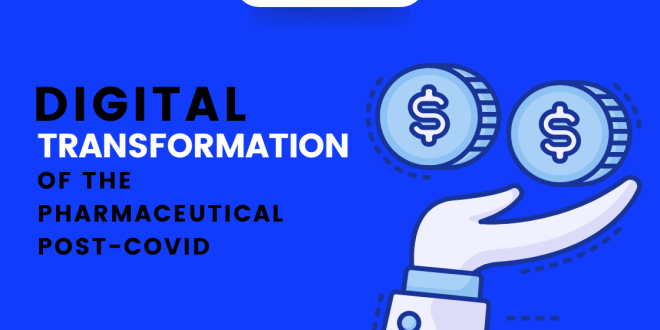Lockdowns, mobility limitations, and social distancing techniques have accelerated the transition of health services and monitoring of patients to remote alternatives, opening the way to more remote medicine, digital therapeutics, and decentralized clinical trials. The pandemic has also changed traditional marketing and sales methods due to the increased need for technology for online marketing and communication.
Since the outbreak, the industry has taken small steps toward digitalization. However, there is much to be done before implementing an end-to-end digital strategy. So, before we get deeper into this topic the issue, it is essential to return to the basics and understand precisely what the ‘digital transformation’ will require.
Pharmaceutical companies across the globe are employing sophisticated machine learning algorithms and AI-powered technology to speed up the process of discovering new drugs. The adoption of AI can boost the effectiveness rate of new medicines and treatments, develop cheaper treatments and cures, and, more importantly, reduce operating costs. Machine learning and IoT, including Robotics, have also been leveraged to automate warehouses, driverless transportation, drone-based deliveries, etc. All of these can all be vital for temperature-controlled Pharma supply chains.
beyond the pill, and creating trust
The pharmaceutical industry is dependent on social platforms and marketing through content to improve their products and marketing; however, their strategies are minimal. The utilization of digital media by companies in pharmaceuticals is only a tiny part of the “digital transformation” that is needed. The need to take an approach based on the consumer is more than just a medication. They are making consumer interactions more critical. Pharma companies have always relied on the trust of their customers to sell their products; however, what is more, important than trust is a long-term partnership. This is why we see pharmaceutical firms no longer as an answer to the problem.
Data analytics and digital tools
Since the COVID-19 law, companies have been forced to update their systems and understand how to support employees working at home. This change predicted to occur in the next 5-10 years has happened within months.
As many patients don’t feel as secure attending the doctor in person as they did before the Covid-19 outbreak, digital health services have increased in popularity among doctors amid the epidemic. Additionally, virtual medicine is vital in reducing the transmission of the virus and the burden on emergency departments.
Before COVID-19, the proportion of patients who sought remote consultation was deficient (only 6 percent). However, digital health has been gaining traction, and at minimum, 19 percent of talks are anticipated to continue to be conducted remotely once the disease has gone away (Source: Statista). Pharmaceutical companies have also seen the digital revolution as an opportunity to enhance their business model. Digitalization offers a fresh stakeholder experience, allowing companies to interact directly with their customers.
360-degree view of patient and physician
Big data used in health care could provide an all-encompassing view of physician and patient patterns, which allows companies to enhance the personalization and effectiveness of treatment. COVID-19 emphasized the importance of converting data to a digital format to build global databases. These databases contain large quantities of information to aid researchers and doctors improve their knowledge of medications and patients to encourage the development of new treatments. This infrastructure will facilitate open partnerships across the industry and lead to better results.
Digitalization for marketing and sales
Through COVID-19, pharmaceutical companies faced difficulties attracting specific particular groups of customers. It is unclear how companies in the pharmaceutical industry can develop relationships with different parties, including physicians and patients. The unexpected social restrictions and lockdowns force innovative, practical ways of connecting with others via multi-access. COVID-19 has forced pharmaceutical firms to implement more reactive, not proactive, selling strategies centered on the immediate crisis and the short-term solutions.
Building as well as Omnichannel Strategy
Pharmaceutical companies need to modify their marketing to include innovative commercial models that appeal to customers over the long term. The companies should think about developing an integrated customer experience comprised of a mixture of channels that provide relevant information and a customized method of communicating with customers. To improve the customer experience, customers must be contacted through their preferred media and be provided with personalized and brand-named documents. Creating an omnichannel strategy enables the pharmaceutical industry to become flexible and ready to change customer behavior or needs.
Mapping the entire journey
Pharma companies have focused on the illness and its treatment. However, the complete journey from health to disease is more complicated and happens in stages. Different entities typically manage the steps; however, If pharmaceutical companies could be in charge of every step in this process, they could effectively provide customers with ongoing care.
Enabling transformation
Technology is leading the direction. Industry must create products that can be designed and developed individually. This means optimizing digital tools and creating interconnected interfaces which assist patients throughout their experience with healthcare. It can be achieved by various means like artificial intelligence, data analytics, and applications and software. In this era of unprecedented change that we live in, digital transformation has to happen quickly. We can redefine and reinvent how the pharmaceutical industry is perceived by using AI and data analysis, which is the perfect time to allow this to occur. It’s not going to be easy, but there are strategies to get through this process, and communication plays an essential part. The two main factors driving commercial activity in pharmacy are necessity and narrative. The condition has been established, and there is a demand for digital change. Nowadays, people are more likely to seek out 360-degree solutions instead of hopping from pillar to post searching for medical assistance.
 Posting Point
Posting Point

